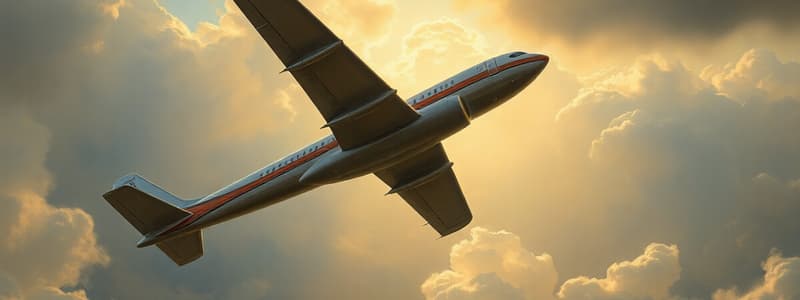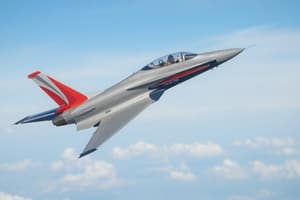Podcast
Questions and Answers
What happens to roll control when the aircraft transitions from ground mode to in flight mode?
What happens to roll control when the aircraft transitions from ground mode to in flight mode?
- The flight crew must manually manage roll and bank angles without assistance
- Rudder is used independently for all roll maneuvers
- The sidestick combines control of ailerons, spoilers, and rudder for turn coordination (correct)
- Control is limited to a single surface for enhanced stability
During the decrab phase, what does the aircraft system do to assist the flight crew?
During the decrab phase, what does the aircraft system do to assist the flight crew?
- Eliminates the need for pedal input altogether
- Limits induced roll after pedal input (correct)
- Reverts to manual flight without restrictions
- Increases roll rate to match pedal input
How is the roll rate affected by the sidestick deflection during flight?
How is the roll rate affected by the sidestick deflection during flight?
- It is proportional to sidestick deflection, with a maximum of 15 °/s (correct)
- It is inversely proportional to sidestick deflection
- It can exceed 20 °/s in specific conditions
- It is fixed regardless of sidestick position
What is a key factor in determining how much control surface deflection occurs on ground mode lateral movement
What is a key factor in determining how much control surface deflection occurs on ground mode lateral movement
Which of the following is impacted by sidestick deflection in an aircraft?
Which of the following is impacted by sidestick deflection in an aircraft?
What happens to control surface effectiveness as aircraft speed changes?
What happens to control surface effectiveness as aircraft speed changes?
What surfaces can be deflected to increase yaw efficiency in the event of an engine failure during takeoff?
What surfaces can be deflected to increase yaw efficiency in the event of an engine failure during takeoff?
In the case of engine failure, which wing's surfaces are primarily adjusted to manage yaw?
In the case of engine failure, which wing's surfaces are primarily adjusted to manage yaw?
What is the purpose of deflecting control surfaces on the opposite wing during an engine failure?
What is the purpose of deflecting control surfaces on the opposite wing during an engine failure?
How does increasing yaw efficiency during an engine failure on ground affect VMCG?
How does increasing yaw efficiency during an engine failure on ground affect VMCG?
What is the primary benefit of reducing VMCG in the event of an engine failure during takeoff?
What is the primary benefit of reducing VMCG in the event of an engine failure during takeoff?
When will the spoiler 6 and ailerons be deflected during takeoff?
When will the spoiler 6 and ailerons be deflected during takeoff?
Which of the following is NOT a condition for deflecting the spoiler 6 and ailerons during engine failure on ground
Which of the following is NOT a condition for deflecting the spoiler 6 and ailerons during engine failure on ground
What happens to the bank angle when the sidestick is released at an angle greater than 33 °in normal law
What happens to the bank angle when the sidestick is released at an angle greater than 33 °in normal law
How does the system respond when the sidestick is held at neutral up to a bank angle of 33 °?
How does the system respond when the sidestick is held at neutral up to a bank angle of 33 °?
What is the maximum bank angle achieved with full lateral sidestick deflection?
What is the maximum bank angle achieved with full lateral sidestick deflection?
Which statement about spiral static stability is true?
Which statement about spiral static stability is true?
What action must the PF take to maintain bank in steep turns?
What action must the PF take to maintain bank in steep turns?
During steep turns, what must be done to maintain level flight?
During steep turns, what must be done to maintain level flight?
What is the minimum bank angle required to qualify as a steep turn?
What is the minimum bank angle required to qualify as a steep turn?
What is the maximum bank angle when angle-of-attack protection is operative and full lateral deflection is maintained?
What is the maximum bank angle when angle-of-attack protection is operative and full lateral deflection is maintained?
What is prevented when high speed protection is active?
What is prevented when high speed protection is active?
What happens when the sidestick is released in high speed protection mode?
What happens when the sidestick is released in high speed protection mode?
Which of the following describes the effect of high speed protection on spiral static stability?
Which of the following describes the effect of high speed protection on spiral static stability?
What occurs when the bank angle exceeds 45 ° during an angle of attack protection and bank angle protection ?
What occurs when the bank angle exceeds 45 ° during an angle of attack protection and bank angle protection ?
What happens to the FD bars when the bank angle decreases to less than 40 ° during bank angle protection .
What happens to the FD bars when the bank angle decreases to less than 40 ° during bank angle protection .
What is the status of auto trim when bank angle protection is active?
What is the status of auto trim when bank angle protection is active?
What color does the sideslip index change to on the PFD in the event of engine failure during takeoff?
What color does the sideslip index change to on the PFD in the event of engine failure during takeoff?
What is the expected pilot response when the beta target cannot be zeroed with full rudder during flight?
What is the expected pilot response when the beta target cannot be zeroed with full rudder during flight?
What state should the ailerons be in to achieve optimum climb performance after an engine failure?
What state should the ailerons be in to achieve optimum climb performance after an engine failure?
What does the lateral normal law command to minimize sideslip during flight?
What does the lateral normal law command to minimize sideslip during flight?
What is the purpose of the PRIM during flight in the context of engine failure?
What is the purpose of the PRIM during flight in the context of engine failure?
Flashcards
Ground Mode Lateral Control
Ground Mode Lateral Control
Sidestick controls aileron and roll spoilers.
In-Flight Lateral Control
In-Flight Lateral Control
Sidestick controls ailerons & spoilers and rudder when required. Manual control while FCS limits roll & bank.
Roll Rate Limit
Roll Rate Limit
Maximum roll rate = 15°/s with full deflection.
Pedal Control
Pedal Control
Signup and view all the flashcards
Flare Mode Lateral Control
Flare Mode Lateral Control
Signup and view all the flashcards
Sidestick Deflection
Sidestick Deflection
Signup and view all the flashcards
Control Surface Deflection
Control Surface Deflection
Signup and view all the flashcards
Aircraft Speed
Aircraft Speed
Signup and view all the flashcards
Relationship: Speed & Deflection
Relationship: Speed & Deflection
Signup and view all the flashcards
Why Speed Matters
Why Speed Matters
Signup and view all the flashcards
Engine Failure Takeoff
Engine Failure Takeoff
Signup and view all the flashcards
Spoiler 6 Function
Spoiler 6 Function
Signup and view all the flashcards
Aileron Function on Takeoff
Aileron Function on Takeoff
Signup and view all the flashcards
Yaw Efficiency
Yaw Efficiency
Signup and view all the flashcards
Increased Yaw Efficiency (Engine Failure)
Increased Yaw Efficiency (Engine Failure)
Signup and view all the flashcards
VMCG
VMCG
Signup and view all the flashcards
How Spoiler 6 Helps
How Spoiler 6 Helps
Signup and view all the flashcards
Aileron Function in Engine Failure
Aileron Function in Engine Failure
Signup and view all the flashcards
Spoiler 6 Deflection
Spoiler 6 Deflection
Signup and view all the flashcards
Aileron Deflection on Takeoff
Aileron Deflection on Takeoff
Signup and view all the flashcards
Conditions for Spoiler 6 & Aileron Deflection
Conditions for Spoiler 6 & Aileron Deflection
Signup and view all the flashcards
Engine Failure Takeoff Goal
Engine Failure Takeoff Goal
Signup and view all the flashcards
Normal Flight Envelope Stability
Normal Flight Envelope Stability
Signup and view all the flashcards
Sidestick Control at 33 Degrees
Sidestick Control at 33 Degrees
Signup and view all the flashcards
Sidestick Control Below 33 Degrees
Sidestick Control Below 33 Degrees
Signup and view all the flashcards
Maximum Bank Angle
Maximum Bank Angle
Signup and view all the flashcards
Lateral Stability System
Lateral Stability System
Signup and view all the flashcards
Steep Turns
Steep Turns
Signup and view all the flashcards
Lateral Pressure
Lateral Pressure
Signup and view all the flashcards
Aft Pressure
Aft Pressure
Signup and view all the flashcards
Why Aft Pressure?
Why Aft Pressure?
Signup and view all the flashcards
Steep Turn Control
Steep Turn Control
Signup and view all the flashcards
Bank Angle Limit
Bank Angle Limit
Signup and view all the flashcards
Lateral Control in Protection Modes
Lateral Control in Protection Modes
Signup and view all the flashcards
Sidestick & Bank Angle Relationship
Sidestick & Bank Angle Relationship
Signup and view all the flashcards
What happens if angle-of-attack, high speed, or negative pitch attitude protection is active?
What happens if angle-of-attack, high speed, or negative pitch attitude protection is active?
Signup and view all the flashcards
How do protection systems limit bank angle?
How do protection systems limit bank angle?
Signup and view all the flashcards
High Speed Protection
High Speed Protection
Signup and view all the flashcards
Spiral Static Stability
Spiral Static Stability
Signup and view all the flashcards
Protection Systems
Protection Systems
Signup and view all the flashcards
Sidestick Control in Protection Modes
Sidestick Control in Protection Modes
Signup and view all the flashcards
Bank Angle Protection
Bank Angle Protection
Signup and view all the flashcards
Autopilot Disconnection & FD Bar
Autopilot Disconnection & FD Bar
Signup and view all the flashcards
FD Bars Return
FD Bars Return
Signup and view all the flashcards
Auto Trim & Bank Angle Protection
Auto Trim & Bank Angle Protection
Signup and view all the flashcards
Sideslip Index Color Change
Sideslip Index Color Change
Signup and view all the flashcards
Sideslip Target During Flight
Sideslip Target During Flight
Signup and view all the flashcards
Lateral Normal Law
Lateral Normal Law
Signup and view all the flashcards
Engine Failure Sideslip
Engine Failure Sideslip
Signup and view all the flashcards
Sideslip Index Purpose
Sideslip Index Purpose
Signup and view all the flashcards
Study Notes
Ground Mode Lateral Control
- Sidestick controls ailerons and roll spoilers.
- Control surface deflection varies with aircraft speed.
- Pedals control rudder directly.
In-Flight Mode Lateral Control
- Normal law combines ailerons, spoilers (except spoiler 1), and rudder for turn coordination.
- Flight crew does not use rudder for turn coordination.
- Flight control system limits roll rate & bank angle, coordinates turns, and dampens dutch roll.
- Roll rate is proportional to sidestick deflection (max 15°/s).
Flare Mode Lateral Control
- Lateral control is the same as in "in flight" mode.
Decrab Phase Lateral Control
- Aircraft limits induced roll after pedal input to ease control.
Transition Between Modes
- Aircraft smoothly transitions to/from "in flight" and "ground" modes.
Studying That Suits You
Use AI to generate personalized quizzes and flashcards to suit your learning preferences.



